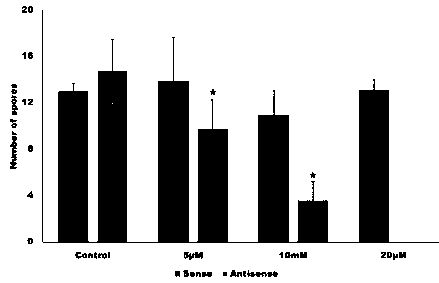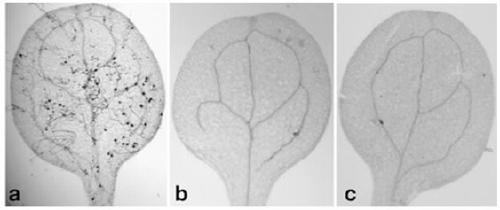A small RNA-based method for inhibiting Arabidopsis biotrophic oomycete downy mildew infection
An Arabidopsis thaliana, vegetative technology, applied in the field of suppressing Arabidopsis thaliana biotrophic oomycete downy mildew infection based on small RNA, can solve the problem of no reliable and efficient Hpa genetic transformation method
- Summary
- Abstract
- Description
- Claims
- Application Information
AI Technical Summary
Problems solved by technology
Method used
Image
Examples
Embodiment 1
[0028] Embodiment 1: experimental method
[0029] 1. Strains, isolation and propagation of pathogenic bacteria: On Ws-eds1, Emoy2 and Cala2 isolated from Arabidopsis biotrophic oomycetes were maintained. Sporulation assays were performed 7 days after inoculation, at the end of the Hpa life cycle. To quantify sporulation, 10 infected seedlings from each replicate were placed in a solution containing 250 μl H 2 0 in Eppendorf test tubes. Vortex samples and count the number of conidia with a hemocytometer.
[0030] 2. The synthesis of sRNA and DNA oligonucleotide: this method takes Hpa-CesA3 gene (HpaG810051) as the target gene, and the sense and antisense sRNAs of different lengths are designed:
[0031] Hpa_CesA3_RNA_AS_24 5'-GCCGCAUCGCACGUACCUCAGUAC-3' (as shown in SEQ ID NO.1);
[0032] Hpa_CesA3_RNA_AS_25 5'-GCCGCAUCGCACGUACCUCAGUACG-3' (as shown in SEQ ID NO.2);
[0033]Hpa_CesA3_RNA_S_25 5'-CGUACUGAGGUACGUGCGAUGCGGC-3' (as shown in SEQ ID NO.3);
[0034] Hpa_CesA3_RN...
Embodiment 2
[0046] Example 2: Screening of sRNA-mediated silencing target genes in HPA
[0047] The main components of the cell wall of oomycetes are β-glucan and cellulose. We targeted the cellulose synthase gene as a target for sRNA-mediated silencing. Using Pfam, we identified that M4BU64 in Hpa belongs to the cellulose synthase gene family. In computer simulation analysis, it was found that this gene corresponds to HpaG810051 in the Emoy2 genome and exists as a single-copy gene. EnsemblProtists gene annotation showed that HpaG810051 had no intron, and the open reading frame encoded a predicted protein of 1144 amino acids (molecular mass 127.028 kDa). BLASTX search of the database showed that HpaG810051 has high similarity with CesA3 protein of other oomycetes, so we named HpaG810051 as Hpa-CesA3. Then we obtained the nucleotide and amino acid sequences of the CesA3 genes of Albucia, Vitiligo, P. lettuce, Phytophthora capsici, P. infestans and Peronospora genus CesA3, and compared t...
Embodiment 3
[0049] Embodiment 3: Hpa-CesA3 antisense sRNA inhibits Hpa sporulation
[0050] Since Hpa is an obligate biotrophic pathogen growing on Arabidopsis, we examined whether HPA-CesA3 has any homology to the Arabidopsis CesA gene. A BLASTN search of the Arabidopsis database found no significant similarities. Subsequently, we designed 25-nt sense and antisense RNA oligonucleotides from the 5' region of the gene without any homology among other genes in the Hpa genome. Add positive and antisense sRNAs to HPA spores at 5, 10, and 20 μM concentrations, respectively, and inoculate 7-day-old Arabidopsis seedlings. On the 7th day (dpi) after inoculation, detect Hpa sporulation situation ( figure 1 ), against the control plants ( figure 1 a) There is no significant difference in the sporulation of plants inoculated with 5, 10, and 20 μM sRNA spore suspension. while the inoculations contained 5 and 10M antisense RNA ( figure 1 The spore suspensions of b and 1c) significantly reduced sp...
PUM
| Property | Measurement | Unit |
|---|---|---|
| molecular weight | aaaaa | aaaaa |
Abstract
Description
Claims
Application Information
 Login to View More
Login to View More - R&D
- Intellectual Property
- Life Sciences
- Materials
- Tech Scout
- Unparalleled Data Quality
- Higher Quality Content
- 60% Fewer Hallucinations
Browse by: Latest US Patents, China's latest patents, Technical Efficacy Thesaurus, Application Domain, Technology Topic, Popular Technical Reports.
© 2025 PatSnap. All rights reserved.Legal|Privacy policy|Modern Slavery Act Transparency Statement|Sitemap|About US| Contact US: help@patsnap.com



